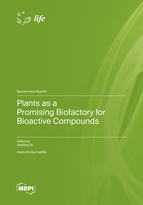Plants as a Promising Biofactory for Bioactive Compounds
A special issue of Life (ISSN 2075-1729). This special issue belongs to the section "Plant Science".
Deadline for manuscript submissions: closed (31 May 2023) | Viewed by 37099
Special Issue Editor
Interests: plant cell culture; plant biotechnology; hairy roots; transgenic plants; recombinant proteins; plant cell wall; glycosylation; biofuels; biochemical engineering
Special Issues, Collections and Topics in MDPI journals
Special Issue Information
Dear Colleagues,
Plants naturally produce a diverse range of bioactive small molecules, such as alkaloids, flavonoids, terpenoids, and phenolic compounds, which are widely utilized as pharmaceuticals and nutraceuticals. Plants can also be genetically engineered to produce valuable recombinant proteins (biologics) for therapeutic and industrial applications, such as cytokines, blood proteins, antibodies, vaccines, and industrial enzymes. The driving forces behind the rapid growth of plant-based biofactories include their low production cost, product safety, and easy scale-up process. Both whole plants and in vitro cultured plant tissues or cells can serve as a viable bioproduction platform. In the past two decades, new strategies that harness metabolic engineering, glycoengineering, and genomic editing have been developed to improve plant production systems, with the aim of achieving commercially significant production. However, major technical challenges, particularly these systems’ low product yields, remain to be overcome.
This Special Issue of Life aims to provide a broad spectrum of reviews and original research contributions that report new strategies and approaches to enhancing the bioproduction of plant biofactories as well as novel functions and applications of plant-produced bioactive compounds. In addition to papers focusing on higher plants, those on microalgae and moss production systems are also welcome.
Prof. Dr. Jianfeng Xu
Guest Editor
Manuscript Submission Information
Manuscripts should be submitted online at www.mdpi.com by registering and logging in to this website. Once you are registered, click here to go to the submission form. Manuscripts can be submitted until the deadline. All submissions that pass pre-check are peer-reviewed. Accepted papers will be published continuously in the journal (as soon as accepted) and will be listed together on the special issue website. Research articles, review articles as well as short communications are invited. For planned papers, a title and short abstract (about 100 words) can be sent to the Editorial Office for announcement on this website.
Submitted manuscripts should not have been published previously, nor be under consideration for publication elsewhere (except conference proceedings papers). All manuscripts are thoroughly refereed through a single-blind peer-review process. A guide for authors and other relevant information for submission of manuscripts is available on the Instructions for Authors page. Life is an international peer-reviewed open access monthly journal published by MDPI.
Please visit the Instructions for Authors page before submitting a manuscript. The Article Processing Charge (APC) for publication in this open access journal is 2600 CHF (Swiss Francs). Submitted papers should be well formatted and use good English. Authors may use MDPI's English editing service prior to publication or during author revisions.
Keywords
- plant cell culture
- plant tissue culture
- medicinal plants
- secondary metabolites
- bioactive compounds
- nutraceuticals
- recombinant proteins
- biologics







